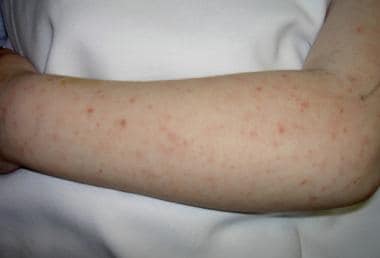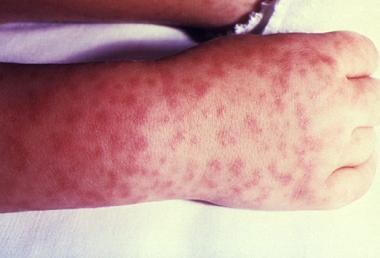History
People with RMSF generally present within a week after a tick bite. Physicians must maintain a high index of suspicion for Rocky Mountain spotted fever (RMSF) in patients with the following:
-
Febrile illness
-
History of potential tick exposure
-
Travel to endemic area
-
Presentation in spring, summer, or fall (although not limited to these seasons)
RMSF should be considered in patients with unexplained febrile illness even if they have no history of a tick bite or travel to an endemic area. History of a tick bite is reported by only 70% of patients. (Most tick bites are painless and may be in hidden areas of the body.)
In a case series by Buckingham et al, of 92 patients eventually diagnosed with RMSF, the median delay between first visiting a health care provider and starting antirickettsial therapy was 5 days. Only 49% of the patients reported a tick bite. [15]
In other studies, 66% of reported cases of RMSF included a history of tick attachment 14 days prior to illness. An additional 26% of patients reported being in a tick-infested area.
The classic clinical triad of fever, headache, and rash may be present in less than 5% of patients in the first 3 days of illness but increases to 60-70% by the second week after tick exposure. The absence or delayed appearance of a rash increases the difficulty of diagnosis.
The most common symptom complaints include the following:
-
Fever greater than 102°F - 94% of reported cases
-
Fever within 3 days after tick bite - 66% of reported cases
-
Headache, frequently severe - 86% of reported cases
-
Myalgias - 85% of reported cases
-
CNS symptoms - 25% of patients develop signs of encephalitis (ie, confusion, lethargy); this may progress to stupor, delirium, seizures, or coma
-
GI symptoms - Some patients present with anorexia, nausea, vomiting, diarrhea, and abdominal pain
Patients may also report insomnia and photophobia.
Physical Examination
Rocky Mountain spotted fever (RMSF) presents with a wide clinical spectrum, ranging from mild fever (usually greater than 102°F), headache, and myalgia to disseminated intravascular coagulation (DIC; 32-53% of patients), shock (7-17%), hypotension (17%), and death (4-8%).
Adults tend to present with typical symptoms. Fever with relative bradycardia is the rule. In mild, untreated cases, the fever subsides at the end of the second week.
Skin
Rash is a major diagnostic sign that appears in a low percentage of patients on the first day of infection and in only 49% of patients during the first 3 days.
 The patient's rash is a major diagnostic sign of Rocky Mountain spotted fever (RMSF). Courtesy of Springer Nature [Bal AK, Kairys SW. Kawasaki disease following Rocky Mountain spotted fever: a case report. Journal of Medical Case Reports. 2009;3:7320. Available at: http://www.jmedicalcasereports.com/content/3/1/7320. Accessed July 25, 2013.]
The patient's rash is a major diagnostic sign of Rocky Mountain spotted fever (RMSF). Courtesy of Springer Nature [Bal AK, Kairys SW. Kawasaki disease following Rocky Mountain spotted fever: a case report. Journal of Medical Case Reports. 2009;3:7320. Available at: http://www.jmedicalcasereports.com/content/3/1/7320. Accessed July 25, 2013.]
 The patient's rash is a major diagnostic sign of Rocky Mountain spotted fever (RMSF). Courtesy of the Centers for Disease Control and Prevention (CDC).
The patient's rash is a major diagnostic sign of Rocky Mountain spotted fever (RMSF). Courtesy of the Centers for Disease Control and Prevention (CDC).
In 88-90% of RMSF cases, the maculopapular rash appears 2-6 days after onset of fever and progresses through stages and distribution that are never pathognomonic. The rash begins as a maculopapular eruption on the wrists and ankles and spreads centripetally to involve the trunk and extremities.
Classic distribution of RMSF rash on the palms and soles occurs relatively late in the course, appearing in 43% of patients only after the fifth day of symptoms. (The hands and the feet are both involved 49-74% of the time.) Some reports have documented 36-80% of patients with RMSF lack the classic distribution of rash on the palms and soles.
The face is usually spared. Involvement of the scrotum or the vulva is a diagnostic clue. Nonproductive cough may accompany the rash (33%).
In the early phases, the rash may be blanching, nonpruritic, and macular. In 45-49% of patients, it eventually becomes petechial; in rare cases, purpura and skin necrosis or gangrene develop. In dark-skinned patients, the rash is difficult to see.
The rash is absent at presentation in 10-15% of patients. RMSF without a rash (ie, spotless RMSF) should be considered ehrlichiosis until proven otherwise. Spotless fever is not synonymous with mild or early illness, because substantial proportions of the deaths occur in patients without a rash.
In older patients and in severe or fatal cases of RMSF, the rash tends to appear later and with less frequency.
Other cutaneous abnormalities that may develop in RMSF include postinflammatory hyperpigmentation, jaundice, and mucosal ulcers. An erythema migrans–like rash has also been reported.
Head, ears, eyes, nose, and throat
Conjunctival suffusion develops in 30% of patients. Bilateral edema is present. Periorbital edema is a key diagnostic finding, especially in children. Transient deafness occurs in 7% of patients.
The incidence of ocular changes in RMSF is considered low but probably is underestimated. Such changes can include petechial conjunctivitis, which occurs as part of the generalized rash, and anterior uveitis.
Retinal vascular dysfunction may result in retinal hemorrhages, retinal ischemia manifested by cotton-wool spots and nerve fiber layer hemorrhages, retinal vascular engorgement and tortuosity, and branch retinal arteriolar occlusion.
Optic disc edema due to ischemia and inflammation and orbital edema from increased extravascular volume may be present. Optic disc edema may be associated with peripapillary subretinal fluid extending into the macula (neuroretinitis).
Cardiovascular
Cardiovascular presentations of RMSF can include the following:
-
Myocarditis
-
Relative bradycardia
-
Arrhythmias - Present in 7-16% of patients
-
Hypotension - Occurs in 7-17% of patients
RMSF is the only tick-borne disease that can directly cause congestive heart failure secondary to myocarditis (5-26%).
Pulmonary
Pulmonary edema occurs in severe cases. Pneumonitis is present in 12-17% of patients. [16]
Gastrointestinal
GI presentations of RMSF can include the following:
-
Anorexia
-
Abdominal pain and tenderness (diffuse in right upper quadrant) - Present in 34-52% of patients
-
Jaundice - Develops in severe cases; it is found in 8-9% of patients
-
Hepatomegaly and splenomegaly - Occur in 12-15% and 14-16% of cases, respectively
-
Diarrhea - Develops in 19-20% of patients
-
Increased aspartate aminotransferase (AST) levels - Present in 36-62% of patients
Musculoskeletal
Musculoskeletal presentations of RMSF can include the following:
-
Severe myalgia - Especially in the legs, abdomen, and back; occurs in 72-82% of patients
-
Diffuse arthralgias
-
Edema on the dorsum of the hands and feet - A key sign; occurs in 18-20% of patients
-
Lymphadenopathy - Develops in 27% of cases
Central nervous system
CNS presentations can include the following:
-
Restlessness and irritability
-
Altered mental status - May include delirium, lethargy, and coma
-
Photophobia
-
Meningoencephalitis (confusion, seizures [8%], focal neurologic deficits)
-
Cranial neuropathies
-
Urinary or fecal incontinence
-
Ataxia - Present in 5-18% of cases
-
Meningismus - Develops in 18% of patients
-
Cranial nerve palsies
-
Hearing loss
-
Photophobia
-
Severe vertigo
-
Dysarthria
-
Aphasia
-
Hemiplegia, paraplegia, or complete paralysis
-
Nystagmus
-
Hyperreflexia
-
Spasticity
-
Fasciculations
Additional presentations
Miscellaneous presentations include dehydration, generalized edema, and chills. Effects of disseminated R rickettsii infection of endothelial cells include increased vascular permeability that leads to edema, hypovolemia, hypotension, and prerenal azotemia.
-
The patient's rash is a major diagnostic sign of Rocky Mountain spotted fever (RMSF). Courtesy of Springer Nature [Bal AK, Kairys SW. Kawasaki disease following Rocky Mountain spotted fever: a case report. Journal of Medical Case Reports. 2009;3:7320. Available at: http://www.jmedicalcasereports.com/content/3/1/7320. Accessed July 25, 2013.]
-
The patient's rash is a major diagnostic sign of Rocky Mountain spotted fever (RMSF). Courtesy of the Centers for Disease Control and Prevention (CDC).
-
In the United States, the American dog tick (Dermacentor variabilis) is the most commonly identified source of transmission. This tick is actually found mainly east of the Rocky Mountains. The Rocky Mountain wood tick (Dermacentor andersoni), found predominantly in the mountain states, can transmit RMSF and tularemia to humans. The brown dog tick (Rhipicephalus sanguineus) is a source of RMSF in the southwestern United States and along the US-Mexico border, but it is found throughout the country and the world. Courtesy of the Centers for Disease Control and Prevention (CDC).
-
An adult female Dermacentor variabilis (American dog tick). Courtesy of the Centers for Disease Control and Prevention (CDC) (https://www.cdc.gov/rmsf/index.html).
-
Annual incidence (per million persons) of Spotted Fever Rickettsiosis (SFR) in the United States, 2018. As of January 1, 2010, cases of Rocky Mountain Spotted Fever (RMSF) have been reported under a new category called Spotted Fever Rickettsiosis (SFR). Courtesy of the Centers for Disease Control and Prevention (CDC) (https://www.cdc.gov/rmsf/stats/index.html#anchor_1531851146113).






